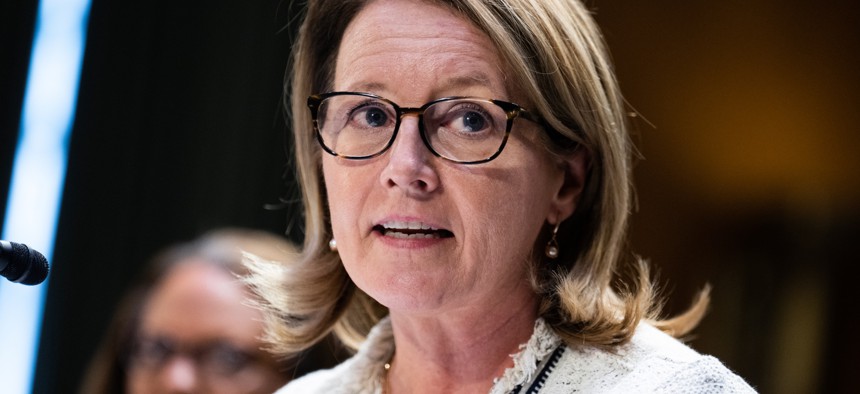
Former FEMA Administrator Deanne Criswell, seen here at a Nov. 20, 2024, Senate Appropriations Committee hearing, said during a House panel Thursday that the agency's natural disaster response will likely be disrupted due to ongoing cuts. Tom Williams / Getty Images
Cuts to FEMA and other agencies will lead to slow disaster response, former administrator says
“It just slows down the entire response and delays the recovery process from starting,” the previous FEMA chief said.
As the Trump administration continues to cut workforces across government, the former head of federal disaster response is sounding the alarm that agencies will be left ill-equipped to handle an onslaught of back-to-back crises.
The Federal Emergency Management Agency is itself losing critical capacity, Deanne Criswell, who served as the FEMA administrator under President Biden, said at a panel hosted by House Democrats on Thursday, the impacts of which will be exacerbated by cuts to its partner agencies. FEMA has shed around 2,000 permanent employees since President Trump took office, or about one-third of its permanent workforce, according to several reports.
Regional and headquarters staff have been impacted, Criswell said, which includes both emergency responders and full-time personnel.
The former administrator said she is most concerned about “the loss of leadership and staff in the regions [and] the loss of institutional knowledge” including how to shift from one disaster to the next without neglecting any responsibilities. She added FEMA may struggle “to stabilize an immediate response for a new event that's happening” and then “pivot back” to support ongoing efforts at an existing site.
She said FEMA needs personnel that go into states to “sit side by side” with leaders there to understand their needs.
“If the state director asks for a resource, then FEMA needs to be able to quickly respond and mobilize that resource to come support whatever that is,” Criswell said, noting that could be a search and rescue team, hospital assessment team or commodities like food and water. “They still need the staff that are going in there. And so when you have less people, you're going to have less ability to actually fill those senior roles.”
FEMA is currently being led on an acting basis by David Richardson, a Trump appointee without prior disaster response experience. Hurricane season began this month and will carry on through November.
FEMA for years struggled with insufficient staffing, which was exacerbated by the ever-growing demands of a more intense and frequent disaster season. That continued into the Biden administration as the COVID-19 response and a lack of downtime between deployments led to burnout within the workforce. Toward the end of Criswell’s term, however, FEMA reported making headway in its recruiting efforts—in part due to a legislative reform that made it easier for part-time responders to come and go from the agency—and officials stressed they had the personnel necessary for multiple concurrent crises.
Accomplishing key tasks on behalf of states without the same level of staffing, Criswell said, will take longer as some efforts get prioritized over others.
“It just slows down the entire response and delays the recovery process from starting,” she said.
President Trump and Homeland Security Department Secretary Kristi Noem have repeatedly said they plan to shut down FEMA entirely, though they have not laid out a plan for what that would look like in practice. Criswell suggested if such a change were implemented, FEMA’s responsibilities would be inefficiently spread out throughout other agencies and states would not have the resources they need to respond to emergencies.
The impacts of the Trump administration's workforce cuts have broad-reaching impacts on disaster response outside of just FEMA, Criswell explained. The Internal Revenue Service, for example, has shed 26,000 employees since Trump took office, including nearly 22% of those in Taxpayer Services, the office that staffs IRS call centers. During emergencies, Criswell said, FEMA taps that resource to help staff the agency’s own call centers offered to disaster victims.
“We had surge capacity,” she said. “Do they have the staff to do that anymore? I don't know. Not likely.”
In some circumstances, Criswell noted individuals were already waiting hours to get through on the phone. Without the additional capacity from IRS, she said, wait times are going to be even longer.
She added FEMA is regularly working with the National Oceanic and Atmospheric Administration, including through the National Weather Service, National Hurricane Center and other offices, to stay up to date on forecasts and prepare for response efforts. NOAA supports FEMA and state emergency responders directly, she said. In places like New Orleans, its staff can help predict where the water will rise and whether the levees will be able to sustain it, in addition to other risks.
NOAA has fired hundreds of employees in their probationary status and pushed out hundreds more through various incentives, though Commerce Secretary Howard Lutnick recently told Congress key positions at the agency are “fully staffed” and some hiring has resumed.
“If they have less staff, they're going to have less ability to embed directly with different jurisdictions to help them understand those impacts,” Criswell said. “And so they are such a critical partner of FEMA, but also of the states and the locals to give them that operational data to make the right decisions to protect their communities.”
Share your news tips with us:
Eric Katz: ekatz@govexec.com, Signal: erickatz.28,
NEXT STORY: Withholding agency funds at the end of the year under consideration, White House says







